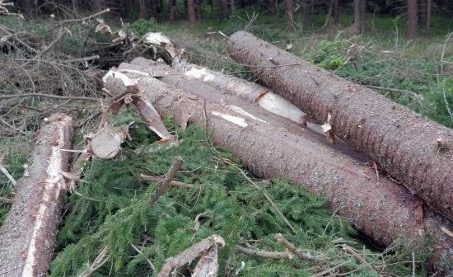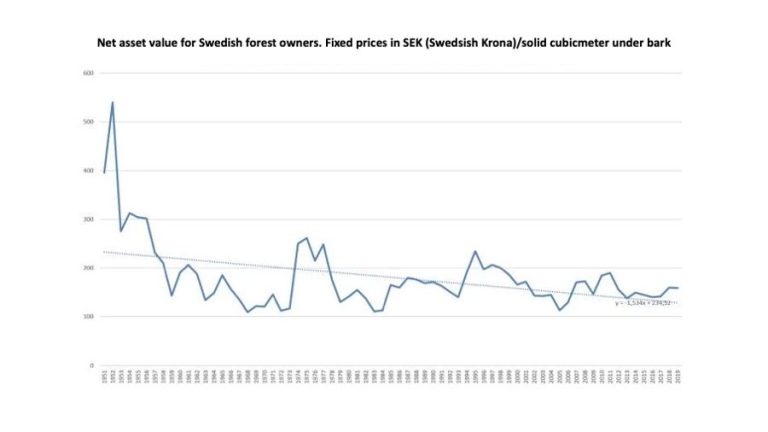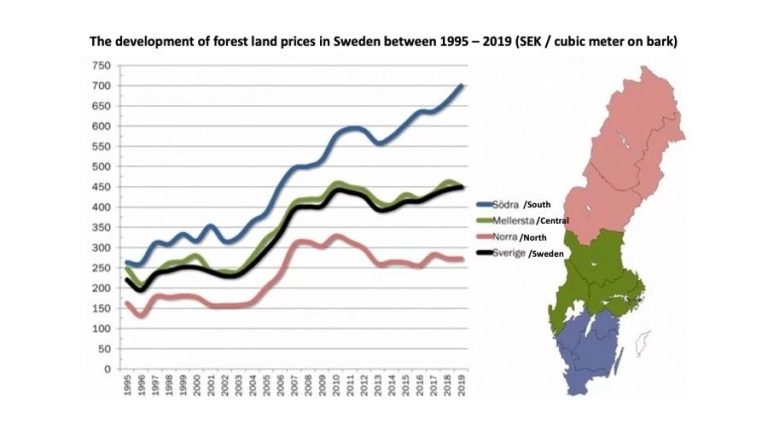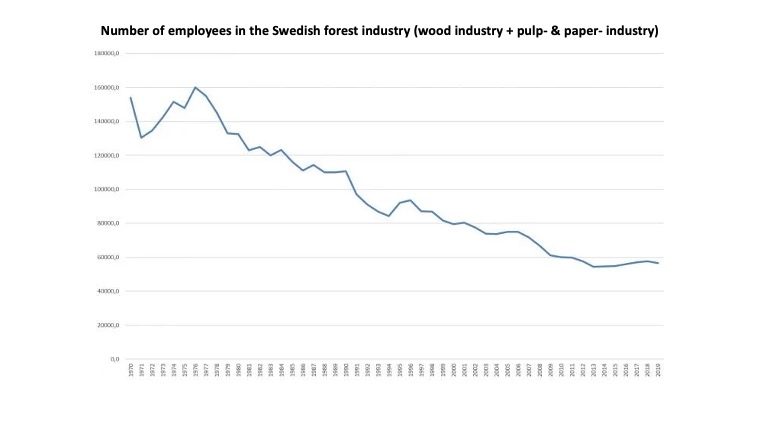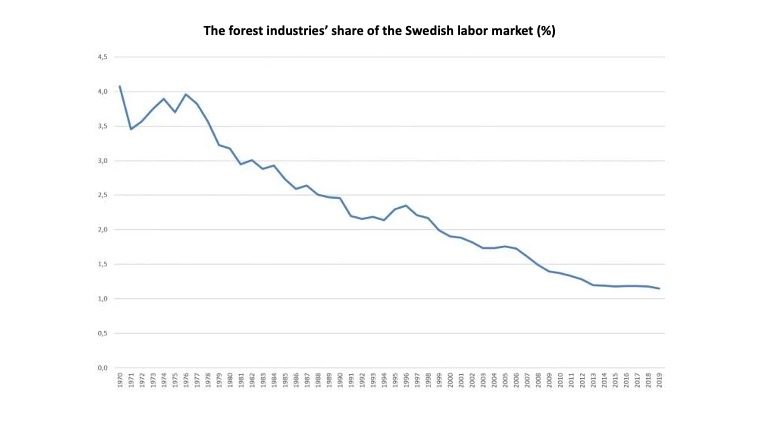The profitability for the Swedish forest owners has decreased over time. The question occurs why we cut at all? Who benefits from it? For whom do we fell the Swedish forest if not for the for the forest owner’s profitability?
Fredrik at the sister-site iSkogen.se had a closer look at this. Here is a summary of his article:
Is the Swedish forest being felled casually?
Who benefits most from the felling of the forest? The natural answer to that question should be the forest owner. But when looking at the development of timber prices during the last 70 years, it doesn´t seem so natural. Are there other reasons to fell, such as for the jobs, the environment, or the industry? Maybe … Let´s have a look at that.
Does the forest owner fell for profitability?
The Swedish Forest Agency, Skogsstyrelsen, have collected statistics of the net asset value since the early 50’s. The net asset value is what is left for the forest owner after a timber deal when the costs for felling and reforestation have been deducted. Looking at the chart below, based on the above-mentioned statistics, the idea that felling is done for the forest owner’s profitability, seems less likely.
Chart: Fredrik Reuter
If you subtract a 30-year average between 1951 – 1971 and 1991 – 2019 the net asset value, and the profitability for the forest owner/seller, have decreased by almost 30 %.
If a forest owner in Sweden wishes to live from the forest alone, he or she will need at least 1000 hectares of forest land and do approx. 12 hectares final felling per year. An estate in that size in Sweden, has a market price of approx. 50 – 70 million SEK (5,1 – 7,1 million USD). So, as mentioned above, the likelihood that the forest owner fells for his or her profitability is negligible.
It´s more likely that the forest is felled to pay loans and interest rates than to make a profit. Many forest owners, especially new ones, simply must fell to make ends meet.
Chart: Ludvig & Co
Is the Swedish forest felled for the forest jobs?
From a national economics point of view, there could be good reasons to fell if it creates job opportunities within the forest industry. What about the statistics here? Well, unfortunately the statistics shows that the likelihood that the forest is felled for the jobs, is small.
In 2013, the Swedish Minister of Trade and Industry at the time in a debate, claimed that the forest contributed to the employment with 200 000 jobs. This figure probably comes from the Swedish Forest Industries meaning that it is unofficial statistics. The corresponding figure of today is a bit confusing as the Swedish site mentions 115 000 jobs, and the English 70 000.
If the Swedish site is right, it means that the forest industry has lost some 10 000 jobs per year between 2013 and 2021. Even more if the English site presents the right figure. As mentioned, this is not official statistics but the industry’s own figures.
According to official statistics by Statistics Sweden, 56 000 were employed within the forest industries in 2020. In 2007, the corresponding figure was approx. 72 000. It´s a decrease by 22 %. If we go all the way back to 1970, the forest industry has lost approx. 100 000 jobs.
Chart: Fredrik Reuter
During this period, the population of Sweden has increased by almost 1 000 000. When looking at the chart below of the forest industry’s share of the Swedish labor market, we see that it has gone from 4 % to 1 % in 44 years.
Chart: Fredrik Reuter
So, to fell the forest to create new jobs also don´t seem to be the reason.
Do we fell for the environment?
Theoretically, we could fell to reach the environmental and climate goals. If so, the products from the forest should be long-term carbon storages such as solid wood or engineered wood and wood products. This kind of material could replace concrete and steel e.g., within the building industry.
Unfortunately, it doesn’t look too good here either as only 21 % of the Swedish timber ends up as wood products. The rest becomes short rotation products as pulp, paper, and bioenergy.
Another reason to fell for the environment could be to fell too old forests, forest that doesn’t grow anymore and has started leaking carbon. However, the Swedish forestry has been so intense during the last 100 years that we have a shortage of old forests. On the contrary, much of what’s being felled today is much too young considering optimal growth and should be left to grow another 10 – 40 years to be optimal for carbon storage and biodiversity.
The conclusion is, as you may have guessed, that we don´t fell for the environment.
Are we felling casually for a bulk industry?
So, is it the forest industry that is the main reason that we fell our forests? When learning about Swedish forest industry the reason should, e.g., because of its size, be that we fell for the industry’s development and profitability. Regardless of this, there are worries also here. Statistics show that the value per cubic meter that we harvest from our forests, is decreasing.
Here we are back to the main question: Are we casually felling the Swedish forests and if so, why?
The truth is that the Swedish Forest industry is not very good at adding value to the forest products. Has focus instead been on increasing the volumes of bulk raw materials for others to process? If so, has this “up-ramping race” meant that the fellable Swedish forests has been mortgaged for the bulk industry?
It seems that we see a locked system where the fellable share of the Swedish forests is claimed for an oligopoly of a forest industry that are going for making more faster – bulk production. Sadly, if this is the case, as it means that new players, with new ideas will find it very difficult to enter the system.
The politicians seem to be on the industry’s side as they grant state funding to start up Bio-CCS in a large scale. The largest pulp boilers will receive those state financed carbon vacuum cleaners meaning that even more pulpwood must be harvested in the Swedish forest for this government investment to pay off.
(Editor Jonsson’s) Conclusion
What Fredrik has dug up in this article, both scares me and makes me sad. The potential to raise the profitability for the forest owners, forest contractors, and the industry seems to be huge. There are so many high value products that could be made from the forest. So, why go for bulk production?
“Money” is an answer that I have received when I ask representatives from the industry. It´s a good reason and so far, the Swedish forest industry has managed to meet the competition from other countries quite well. But partly at the cost of less profit for the forest owners and the contractors doing the felling and the reforestation.
And then we have the EU Commission’s new Forest Strategy for 2030 that notes that wood and wood products are good (as they store carbon for a long time), pulp- & paper products are less good (as they store carbon for a short time), and bioenergy is not good at all (as it lets the carbon out immediately). As a member state in the EU Sweden will have to adapt to the new strategy sooner or later.
Why not start the adaption right now by moving (slowly) away from bulk production towards more processed, value added, and carbon binding products such as engineered wood?
I know, it’s a huge change for the forest industry, but why wait? It must be better to do the investments now when the industry is still doing fairly well, than to wait until they are out of business.
As for the forest owners and forest contractors, they will probably be better off if the industry produces more expensive and profitable products than they are today.






